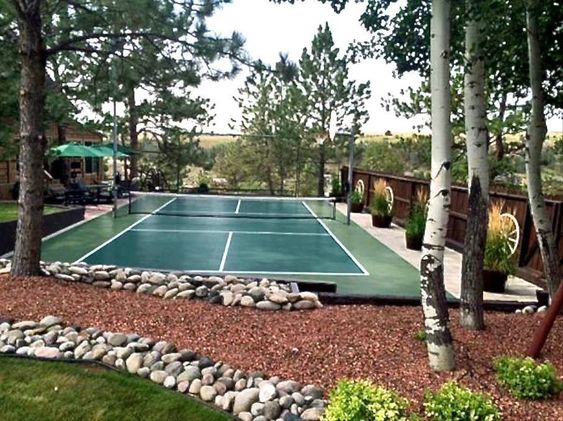Discover the most effective Pickleball Court Layouts for Optimal Gameplay
Discovering the intricacies of pickleball court formats can considerably enhance the gameplay experience for both newbies and seasoned players alike. With exact measurements, strategic shade selections for court lines, and ideal web elevation, the arrangement of a pickleball court adds considerably to the flow and strength of suits.

Criterion Pickleball Court Dimensions
What are the standard measurements of a pickleball court that gamers must adhere to when establishing up a suit? A guideline pickleball court measures 20 feet broad by 44 feet long for both songs and increases play. The court is separated into left and ideal service courts by a centerline, which is 20 feet from each sideline.
Impact of Court Line Colors
The criterion dimensions of a pickleball court play a fundamental function in forming the video game's structure and fairness, and the selection of court line shades further enhances the playing experience by affecting visibility and court appearances. When selecting colors for the court lines, it is important to consider elements such as comparison, brightness, and colorblindness to guarantee maximum exposure for gamers of all ages and capabilities. High-contrast shades like black, dark environment-friendly, or navy blue are frequently liked for detailing the limits of the court as they develop a clear distinction against the lighter having fun surface area. In addition, using bright and vibrant shades for the non-volley area or kitchen lines can assist gamers swiftly identify these critical locations during busy gameplay. Incorporating shade plans that enhance the total court layout can contribute to the visual allure of the playing location, improving the general pickleball experience for players and spectators alike.
Value of Web Elevation
Effective gameplay and player experience in pickleball are substantially influenced by the specific regulation of net elevation (Pickleball court construction). The common net elevation for pickleball is 34 inches at the facility and 36 inches at the sidelines. Maintaining this elevation is vital to make certain justice and enjoyable gameplay for all participants
An internet set also low can lead to more powerful knockouts and less calculated play, preferring aggressive players. Sticking to the defined net height is important to promote an equilibrium between offensive and defensive strategies, promoting a competitive yet satisfying setting on the court.
Moreover, regular internet height across different courts is crucial for players to adjust their skills and tactics flawlessly. Pickleball court construction. Gamers count on the harmony of net elevation to establish their methods and enhance their gameplay, stressing the importance of keeping the prescribed dimensions for optimum pickleball experiences
Trick Functions of Side Secure Fencing
Provided the crucial duty of web elevation in regulating gameplay characteristics, an equally crucial aspect to think about in enhancing the general pickleball court setting is the essential attributes of side fencing. Side fence offers multiple crucial purposes in a pickleball court design. It offers borders that help define the playing location, making certain that the ball stays within the court during gameplay, hence decreasing interruptions. Furthermore, side fence works as a safety and security barrier, avoiding players from mistakenly tipping out of bounds and potentially getting injured. The presence of side fencing can also help decrease interruptions from outside aspects, such as spectators or surrounding activities, enabling players to focus better on their game. When designing or selecting a pickleball court format, it is crucial to take into consideration the product, elevation, and toughness of the side fence to make sure ideal gameplay conditions and total court visual appeals. Well-constructed side secure fencing boosts the playing experience, promotes safety, and adds to a specialist and orderly pickleball environment.
Using Non-Volley Zone Successfully

One secret element of utilizing the Non-Volley Zone effectively is recognizing its critical value. By placing oneself near to the kitchen that site line, gamers can place pressure on their opponents by restricting their capacity to redirected here hit aggressive shots near the web (Pickleball court construction). This calculated positioning can require opponents right into making errors or weak returns, allowing gamers to preserve control of the game
Moreover, gamers can utilize the Non-Volley Zone to establish up offensive plays. By striking shots that require challengers to hit the round high and potentially into the Non-Volley Area, players can relocate near to the net and implement winning shots. This calculated use of the Non-Volley Area can assist players determine the pace of the video game and eventually lead to success on the pickleball court.
Verdict
To conclude, understanding the typical dimensions of a pickleball court, the influence of court line colors, the importance of web height, crucial features of side fence, and how to use the have a peek at these guys non-volley zone successfully are all important for optimum gameplay. By incorporating these aspects into your gameplay method, you can boost your overall efficiency on the court and improve your possibilities of success in pickleball suits.